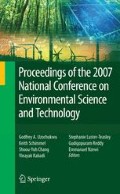Abstract
North Carolina ranks as the 2nd largest hog producer in the United States. Currently, the state houses over 10 million hogs. It is estimated that about 19 million tons of hog waste was produced in 2004 by the 10 million hogs in the state (scorecard.com). Despite the increase in waste output due to increased production, concerns are that majority of these producers have not improved their waste management practices. Most importantly, all the big factories are located in counties in the Black Belt region of the state. These are counties where the percent Black population is greater than the state and national averages of 25.4% and 12% respectively. The existence of pollution, poverty, and minority populations in a given area, more often than not, raise questions about environmental justice. Statistical and geographical information systems (GIS) analyses are performed at the zip code level to whether relatively poor, nonwhite populations are disproportionately exposed to hog waste directly or indirectly. The results indicate that these populations are not directly targeted but their association with poverty and also being rural dwellers help explain their disproportionate exposure.
Access this chapter
Tax calculation will be finalised at checkout
Purchases are for personal use only
References
Anderton, D., A. Anderson, J. Oakes, and M. Fraser. 1994a. “Environmental Equity: The Demographics of Dumping.” Demography 31: 229–248.
Anderton, D., A. Anderson, P. Rossi, J. Oakes, M. Fraser, E. Weber, and E. Calabrase. 1994b. “Hazardous Waste Facilities: Environmental Issues in Metropolitan areas.” Evaluation Review 18: 123–140.
Anderton, D. 1997. “Methodological Issues in the Spatiotemporal Analysis of Environmental Equity.” Social Science Quarterly 77: 508–515.
Asch, P., and J. J. Seneca. 1978. “Some Evidence on the Distribution of Air Quality.” Land Economics 54(3): 278–297.
Bowen, W., M. Sailing, K. Haynes, and E. Cyran. 1995. “Toward Environmental Justice: Spatial Equity in Ohio and Cleveland.” Annals of the Association of American Geographers85: 641–663.
Bullard, R. 1983. “Solid Waste Sites and the Black Houston community.” Sociological Inquiry 53: 273–288.
Clark, R., S. Lab, and L. Stoddard. 1995. “Environmental equity: A Critique of The Literature.” Social Pathology 1: 253–269.
Environmental Defense Fund/Green Media Toolshed 2005. (http://www.scorecard.org).
Glickman, T. S. 1994. “Measuring Environmental Equity with Geographical Information Systems.” Resources116: 2–6.
Hamilton, J. T. 1995. “Testing for Environmental Racism: Prejudice, Profits, Political Power?” Journal of Policy Analysis and Management 14: 107–132.
Hird, J. A. 1993. “Environmental Policy and Equity: The Case of Superfund.” Journal of Policy Analysis and Management 12: 323–343.
Hird, J. 1994. “Superfund: The Political Economy of Environmental risk.” Baltimore, Maryland.
Mohai, P., and B. Bryant, 1992. “Environmental Racism: Reviewing the Evidence.” In Race and the Incidence of Environmental Hazards, ed. Bunyan Bryant and Paul Mohai, Boulder, Colorado: Westview Press.
North Carolina Pork Council. 2004. “North Carolina Pork and the Global Economy.” North Carolina Pork Council, 2006, “Weekly Briefing”. The Porkline 8: 30.
Pastor, M., J. Sadd, and J. Hipp. 2001. “Which Came First? Toxic Facilities, Minority Move-in and Environmental Justice.” Journal of Urban Affairs 23(1): 1–21.
Stretesky, P., and M. J. Hogan 1998 “Environmental Justice: Analysis of Superfund sites in Florida.” Social Problems 45(2): 268(20).
Taylor, D. 2000, “Introduction, Advances in Environmental Justice: Research, Theory, and Methodology.” Special Issues of American Behavioral Scientists 43(4): 504–507.
U.S. Environmental Protection Agency. 1994. “Environmental Justice Initiatives, 1993.” Washington DC: U.S. Government Printing Office. EPA 200-R93-001.
U.S. Bureau of Census. 1990. (http://www.census.gov).
U.S. Bureau of Census. 2000. (http://www.census.gov).
U.S. General Accounting Office. 1983. “Siting of Hazardous Waste Landfills and their Correlation with Racial and Economic Status of Surrounding Communities.” Washington, DC: U.S. GAO.
United Church of Christ. 1987. “Toxic Waste and Race in the United States.” New York: United Church of Christ.
Walker, R., and F. Calzonetti. 1989. “Searching for new Manufacturing Plant Locations: A study of Location Decisions in Central Appalachia.” Regional Studies25: 15–30.
Wheeler, J. O., and P. O. Muller. 1986. “Economic Geography” 2nd. Ed. New York: John Wiley and Sons.
Yandle, T., and D. Burton. 1996. “Reexamining Environmental Justice: A Statistical Analysis of Historical Hazardous Waste Landfill Siting patterns in Metropolitan Texas.” Social Science Quarterly 77: 479–492.
Zupan, J. M. 1973 “The Distribution of Air Quality in the New York Region.” Baltimore: John Hopkins.
Author information
Authors and Affiliations
Editor information
Editors and Affiliations
Rights and permissions
Copyright information
© 2009 Springer Science+Business Media, LLC
About this paper
Cite this paper
Yeboah, O., Thomas, T., Foster, T., Fosu, E. (2009). Pollution, Environmental Justice, and the North Carolina Pork Industry. In: Nzewi, E., et al. Proceedings of the 2007 National Conference on Environmental Science and Technology. Springer, New York, NY. https://doi.org/10.1007/978-0-387-88483-7_18
Download citation
DOI: https://doi.org/10.1007/978-0-387-88483-7_18
Published:
Publisher Name: Springer, New York, NY
Print ISBN: 978-0-387-88482-0
Online ISBN: 978-0-387-88483-7
eBook Packages: Earth and Environmental ScienceEarth and Environmental Science (R0)

